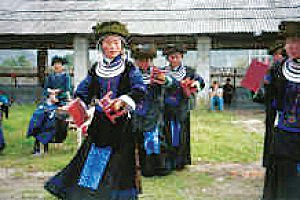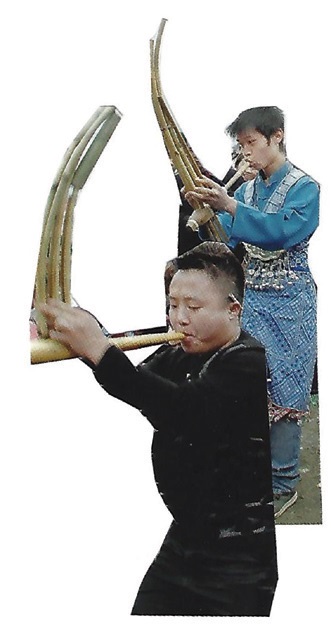
| What is Flavor and Fortune? |
| How do I subscribe? |
| How do I get past issues? |
| How do I advertise? |
| How do I contact the editor? |
Read 13076624 times
Connect me to:
| Home |
| Articles |
| Book reviews |
| Letters to the Editor |
| Newmans News and Notes |
| Recipes |
| Restaurant reviews |
| Article Index (all years, slow) |
| List of Article Years |
| Article Index (2025) |
| Article Index (last 2 years) |
| Things others say |
| Related Links |
| Log In... |
| Authors |
| Categories & Topics |
Miao: China's Fifth Largest Ethnic Group
| by Jacqueline M. Newman |
Chinese Ethnic Minorities and Their Foods
Fall Volume: 2018 Issue: 25(3) pages: 30 to 32
One of China’s largest minority populations, the fifth in size, the Miao, now probably include ten million according to the last census in 2010. These folk are linguistically related and speak one of the Miao-Yao language families that includes the three main dialects of Central, Northern, and Southern Miao-Yao. The Chinese government did help them ease oral differences with each other by helping them develop a written language.
In the United States (US), they call themselves Hmong as they do not like the name of cats crying out. In China, they are not excited about their name either, as it is slang for ‘barbarian.’ Others call them or they are called Xing, Qo, Xiang, A-hmao, Meau, Mo, Ka Nao, Hmu or other self-designated names. In China, the government since the late 1940s have grouped all of these folk simply as Miao.

Theirs is more than a five thousand year history. Many of them believe they may be descended from the Jiuli tribe, led by Chiyou, defeated at the Battle of Zhuolu on the border of Hebei and Loaning Provinces. All do not agree, many say they lived in what is now China’s southwest in either Guizhou, Hunan, Yunnan, or in the Guangxi Zhuang Autonomous Region, or in Sichuan, Guangdong, or in Hainan. Still others believe they were the first people to settle in present day China. These days many live outside China in Vietnam, Laos, Burma, Thailand, or in the US. Thousands did come to Western US cities when their resettlement was supported by a host of volunteer agencies.
Some say and believe they are descended from aboriginal groups that gave them a hard time years ago and so they left their homeland and moved to larger cities where they now live. Not all like or believe they are Miao, or think they are partially Miao. They name themselves by the color of their women’s clothes; and if, for instance, they wear black tops, they call themselves Black Miao, or Green or Blue Miao, etc.
One legend some of them tell us is that they are descended from the Juili tribe, defeated in battle by two large military battalions. Or, they may be connected to the Daxi culture from six thousand years ago. Others tell other stories including that their ancestors were the first to cultivate or domesticate rice; maybe lived in the Shandong Province or nearby in Pre-Qin times (before 221 BCE). One group even said they may not be Han Chinese at all.
Not experts in their or anyone’s history, they did and still cook their rice in huge quantities needing to do so at least twice every day. Theirs is a patrilineal animistic group who love hot pepper sauces with beef, chicken, pork, or doufu. They prefer eating sticky rice with their hands, and they like pork mixed with egg, rice, corn, or wheat and with other meats and bean threads, and with soups sweetened with fried flour and long-soaked soy beans.
Common Miao recipes were published in the Summer 2002 issue, a few adapted from pamphlets found at a Hmong food store in Minneapolis where many in the US now live. The largest concentration of Hmong in the US reside in California, but we did not discover any Hmong recipe publications there. The booklet we found has recipes in cooperation with the New Citizens Hmong Garden Project sponsored by the South Saint Paul Church in MN. There are other groups in Rhode Island with booklets, but none was available when we looked there, we were told most main meals did include, onions, mustard greens, sweet potatoes, and prepared sauces. If you go to where we found the one whose recipes we worked with, note it is at 2601 12th Avenue South.
Their foods differed little from those we tasted in China where we did learn they do eat differently in different places. Several we spoke to related unasked, that they are proud and did help Chairman Mao escape the communists when they were farmers in China. Another point of pride was in the US, their women do make money selling their crafts.
We learned that Miao do not like to marry someone with the same family name even if not related. There are many other marital practices, and different celebrations of different holidays depending on where they came from. Some are the same holiday practiced on different days or dates. One example, several Hmong ladies in different places, did tell us of enjoying Ya Nu’s birthday. However, not all said it was April 8th or a day related on the Lunar calendar when they enjoyed that event. He was one of their ancient honored leaders. They also said they celebrate Chinese New Year, Dragon Boat Festival, Flower Mountain Holiday, New Rice Festival, Sister’s Holiday, Autumn Market Day, and Spring Festival, on different days, which can be months apart.
The Maio/Hmong have a rich heritage; most are orally shared songs and stories, a few are folk dances they say tell tales of their past. These seem similar no matter where they did or now live, and they are popular and important. They have survived for generations even though before 1956, they had no written language until the Chinese government did help then put one together.
In China now, they can and do speak to and understand each other, thanks to required public education. Almost all do recognizable and beautiful arts and crafts, embroidery, waxbatik, making of silver ornaments, and paper-cutouts; and most can play the lusheng, their special long bamboo pipe instruments of five or six feet in length.

In China, many of these folk live in wooden houses sitting on tall pillars that have tiled roofs. Their animals are kept underneath the floor they live on and where their kitchens are. They do store some staples below, often rice, glutinous rice, maize, millet, sweet potatoes, or other starches. These they cook with meat and in an acidic soup or sauces, and serve them with pickled or sour vegetables. Some were not cooked but made packed in sealed jars stored for several months. Once opened, they eat and love them.
Most Miao prepare and eat their sauces using mortar and pestle, steamers, spoons, forks, and chopsticks. They rarely use milk products, adore all meats, and eat many different fruits and vegetables. At funerals, their men wear very elaborate clothes, but their women do not, just adorn themselves with lots of silver jewelry. They like their homes to have one door facing East; and why we could not learn. We did learn their single folk date and go in and out of these east-facing doors day and night to visit those of the opposite sex. All eat traditional foods including colored rice balls, and drink homemade rice wine with the sour foods.
The Summer issue of 2002 includes three of their loved recipes, particularly the one called Spicy Dipping Sauce, also known as Hot Pepper Sauce. They use it with most of their foods, and feel like they are lost when this is missing from their daily diet. Enjoy their other recipes below; and should you learn of others, we hope you will share them with us.
| Steak With Gall Bladder |
|---|
pound steak filet or loin, cut in quarter-inch slices, broiled for two minutes, cooled, and angle-sliced
1. Cut broiled meat and the gall bladder into small
strips, and put them in a bowl.
|
| Mustard Greens Soup |
|---|
½ cup chopped smoked pork or chopped belly pork
1. Simmer pork covered in broth for half an hour, and
skim as needed.
|
| Pork and Eggs |
|---|
1½ cups granulated sugar
1. Heat sugar with two cups of cold water stirring with a
wooden spoon until the sugar is dissolved and it turns
a light brown.
|
| Chicken Wings and Bitter Melon |
|---|
2 bitter melons, cut in half the long way, seeds removed and discarded, and cut in half-inch slices
1. Soak bitter melons in water, toss them for three to five
minutes, then discard the water.
|
| Pork and Bean Thread Noodles |
|---|
1 pound ground pork
1. Mix pork and oil, put in a pre-heated wok or fry pan,
and stir-fry for three minutes. Discard excess oil, the
add cilantro, scallions, fish sauce, black pepper, mint
leaves, and piquant pepper pieces and stir-fry for three
minutes.
|
| Doufu With Chicken |
|---|
5 Tablespoons vegetable oil
1. Heat wok or fry-pan, add half the oil then the eggs
and scramble them until soft, then set them aside.
|

Copyright © 1994-2025 by ISACC, all rights reserved
Address
3 Jefferson Ferry Drive
S. Setauket NY 11720